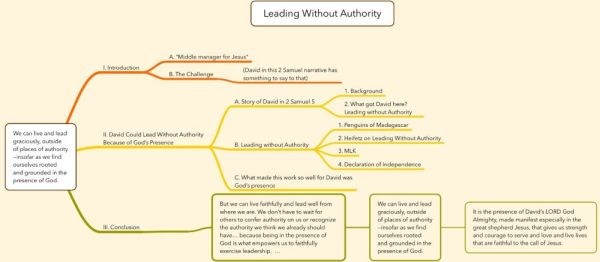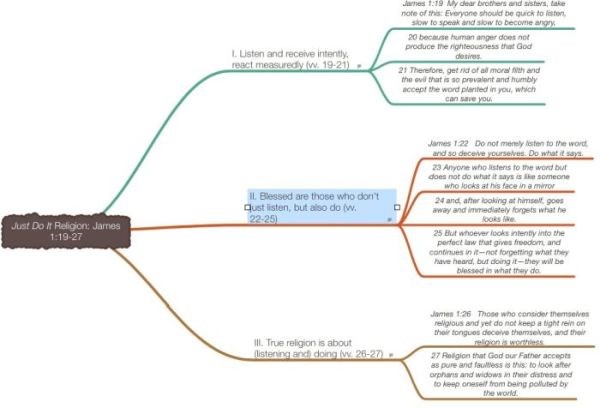Skill Builders
Article
How Mind Mapping has Rejuvenated My Sermon Preparation

I first heard about mind mapping from a former colleague. I had seen his visually appealing planning notes. I had even asked for a quick tour of the advanced computer program he used to generate graphical outlines. He had planted a seed, but I didn't pursue it further. A couple years later, a combination of the daily appearance of mind maps in my Twitter feed and the need to jump start my sermon outlining led me to finally give it a try.
I confess that at first I thought mind mapping was gimmicky. Some people swear by this way of collecting and organizing ideas, spatially mapping interconnections. Mind mapping proponents praise the method for its ability to help you explore conceptual connections you otherwise might miss—or to clearly see what's already in your head.
I was an unlikely candidate. I do not consider myself remotely artistic—except for my guitar playing, but that has limited exegetical value. I am not much of a visual learner. And I've actually been fairly happy with linear thinking-oriented text editors like Word or Pages or the more robust Scrivener.
But last summer when I tried mind mapping—in short, a method of spatial outlining—to make sense of David's kingship in 2 Samuel, the practice opened up new worlds of creativity to me.
How I mind map
I was looking at preaching four weeks through 2 Samuel lectionary readings. I try to preach a balanced diet of biblical genres, and had found that I was neglecting Old Testament historical narratives like Samuel, Kings, and Chronicles. So I dipped into the lectionary as it covered some highlights (and the major lowlight) of David's rule.
To get some help on preaching Old Testament narrative I did what any tech-savvy preacher would do: I turned to a new app for help. (I prayed, too.) I'd heard of mind mapping before, but I had worried that the nodes and sub-nodes and visual links would cause my sermon outline to get out of control. But mapping actually freed me to see relationships between parts of the text that a single screen of Microsoft Word couldn't show.
My first mind map was of 2 Samuel 5:1-10. David was already ruling in Hebron. The passage describes his shift to reigning over all Israel from Jerusalem. I noted David's ability to lead faithfully without positional authority. As I read the text more closely, it became clear that David's ability to move up in his world was not a result of his faithfulness; it was because of God's presence with him. It says, "And he became greater and greater, because the LORD God Almighty was with him."
There it is—the key to so-called leadership success: being grounded in and surrounded by the presence of God. I had landed at my central idea for the sermon: We can live well and lead from wherever we are, not having to wait for others to confer authority on us, because being in the presence of God is what empowers us to be faithful.
I sat at my computer and opened up MindNode, a mind mapping app for Mac, iPad, and iPhone. The big idea became my central node, the primary shape in my mind map to which everything else would relate. So I selected "New Main Node," which gave me a box into which I typed that text. From there I wanted to make space for mapping out an introduction, a body, and a conclusion. So using the app, I easily added those three more sub-nodes, branching out from my big idea. My first-ever sermon mind map was starting to take shape:

I knew I wanted to lead off with my own personal "middle manager for Jesus" experience—so I made that a new sub-node for the introduction. I knew, too, that the body would need to include some setup of the passage and exposition of it, since it was our first Sunday in 2 Samuel. Once I had set the stage, I would talk in the body about leading without authority, a concept I already had some notions of how to illustrate (Martin Luther King, Jr., The Declaration of Independence, Penguins of Madagascar). Those would all be sub-sub-nodes, a.k.a. "child nodes" to the "parent nodes."
No sermon ever actually writes itself, but once I started the mind map, this one came out more easily than many others. Before long, I was looking at my final outline:

At this point, MindNode allows me to export the mind map a number of ways, including as a text outline to a word processing app. It is here that my new practice feeds back into my familiar workflow of writing a fuller outline and then manuscript in a word processing program. Sometimes I've found a given mind map so useful in keeping me tied to the big idea and overall structure that I've written the entire manuscript into the mind map itself. (You can add "notes" to nodes in any mind mapping program.) By the time I move out of mind mapping and back into word processing, the sermon writing is nearing completion.
The benefits of mind mapping
Don't be fooled by the shiny-new-app mentality; you can also mind map with pencil and paper. I prefer the electronic method because you can quickly record thoughts on a screen and then drag and drop your way into a coherent outline. It's been a productive tool for me to understand the texts I speak on each week.
One specific way I've employed mind mapping is to first outline my text. I will copy the biblical text verse-by-verse and paste each verse into its own node.

Then as I see connections emerge, I group verses together by theme.

A passage outline, of course, does not always translate right to a sermon outline, but once I've outlined the passage using a mind map, a preaching outline is not far behind.
Consider a workflow adjustment
It strikes me that sermon prep workflow can fall into two extremes. First, there's the "don't mess with success" approach of just sticking with all the tools that have "worked" for years, wanting to leave well enough alone. This approach leads to boredom and staleness, even if the process is good. But there's also the "constant tinkering" approach of using a good app for mind mapping one week, and then spending two hours of would-be sermon prep time seeking out better tech tools. (Ummm … not that I've ever done that.)
If you can withstand the temptations of the "constant tinkering" approach, and if the former "don't mess with success" approach sounds like you, you might consider spicing up your sermon preparation workflow with mind mapping—whether in its electronic or analogue expressions. I had already been tinkering with too many word processing and Markdown apps when I discovered mind mapping. Mind mapping may or may not connect with you in your sermon writing each week, but it's at least worth a gander. My own time in the study (coffee shop, dining room table, waiting room) has been rejuvenated by it. It turns out it wasn't a new app, but a new way of visualizing and processing biblical texts that I needed. It's now a staple part of my weekly process.
Abram Kielsmeier-Jones is Pastor of Union Congregational Church in Magnolia, MA, writer, husband, father, and follower of Jesus. He writes at Words on the Word and is on Twitter at @AbramKJ.










